Prevalence of Text Neck Syndrome among Doctors
DOI:
https://doi.org/10.5530/jcram.2.2.9Keywords:
Text neck syndrome, Mobile phones, NomophobiaAbstract
Purpose: The aim of this study was to investigate the prevalence of text neck syndrome (TNS) among doctors of North India and to assess the impact of increase in duration of time spent with mobile phones on TNS. Methods: The present study is an observational cross-sectional questionnaire based survey that included doctors practicing in North India. An electronic survey of 28 questions consisting of open-ended, closed-ended questions, and five-point Likert scale questions was developed using Google Form, which was sent to all the participants on October 19, 2020 through social media. Logistic regression analysis was performed to find relationship between discrete variables. The independence of attributes was measured through chi-squared test. Results: There was significant increase in the duration of mobile usage after lockdown as compared with pre lockdown period [ c2 = 68.87; df = 16; p < 0.001]. There were more complaints of neck pain in respondents whose duration of mobile usage per day was greater than 5-6 hr [odds ratio = 9.6; p = 0.005]. There was no significant difference between time duration of mobile usage across gender [c2 = 8.41; df = 4; p < 0.08]. Similarly, There was no significant difference between time duration of mobile usage across gender in prelockdown period [c2 = 3.97; df = 4; p < 0.41], while males reported to spend more time on mobile during post lockdown period [c2 = 8.41; df = 4; p < 0.08]. Conclusion: We ascertained a statistically significant increase in TNS after lockdown during unrivaled era of COVID-19 pandemic which was associated with more exposure to mobile phones. Additionally we confirmed that, there was no significant difference between time duration of mobile usage across gender.

Downloads
Published
How to Cite
Issue
Section
License
JCRAM and its contents are licensed under a Creative Commons Attribution-Non Commercial-No Derivs 4.0 License. Permissions beyond the scope of this license may be available with editor@jcramonline.com






